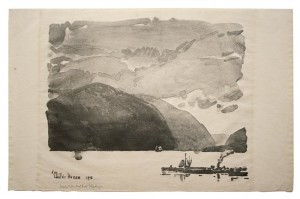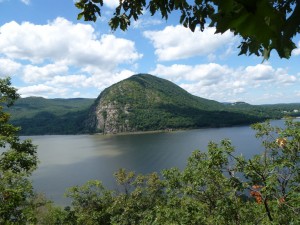Except for the 1990 Al Hirschfeld lithograph of Louis Armstrong that we bought after Satchmo at the Waldorf opened, Mrs. T and I haven’t added anything to the Teachout Museum for quite some time. So it was a very big deal when I learned last month that an art dealer in California was offering for sale a copy of Storm King, a 1918 lithotint by Childe Hassam.
 Hassam and John Henry Twachtman were the two most important American impressionist painters, and while Twachtman made only a comparatively small number of prints, Hassam devoted a considerable amount of time and energy to the medium from 1915 until his death in 1935. I don’t care for his etchings, which mostly strike me as fussy and quaint, but his lithographs are far more individual, and “Storm King,” whose subject is the mountain of the same name that overlooks the Hudson River, is one of his finest works in any medium.
Hassam and John Henry Twachtman were the two most important American impressionist painters, and while Twachtman made only a comparatively small number of prints, Hassam devoted a considerable amount of time and energy to the medium from 1915 until his death in 1935. I don’t care for his etchings, which mostly strike me as fussy and quaint, but his lithographs are far more individual, and “Storm King,” whose subject is the mountain of the same name that overlooks the Hudson River, is one of his finest works in any medium.
As Elizabeth E. Barker wrote in “Hassam’s Prints,” the definitive essay on the subject:
In addition to lithography, Hassam explored the related technique of lithotint, in which the artist uses a brush to apply washes of tusche (a black liquid made of the same materials as the lithographic crayon). Hassam prepared his lithotints—unlike his lithographs—directly on the stone. His last, Storm King, ranks as a masterpiece of the form: the ominous mountains that pierce the cloudy sky and dwarf the miniscule ship may reveal Hassam’s own emotions in wartime….
Today Hassam’s bold late printmaking style may suggest links to modern European art. The powerful linear forms of his lithographs resemble the interlocking planes that structure paintings by Paul Cézanne.
I agree, which is one of the reasons why I have coveted “Storm King” ever since I first saw it reproduced in a catalogue. Not only is it breathtakingly beautiful in its own right, but it fits neatly into our collection of works on paper by America’s midcentury modernists and their turn-of-the-century forerunners. I never dreamed that we would be able to own a copy—only forty-nine impressions were made, most of which are now in museums—but now we do, and Mrs. T and I are planning to hang it close to our treasured copy of Twachtman’s Dock at Newport, one of the very first pieces that I bought after I started collecting American art eleven years ago.
 “Storm King” also has special meaning for the two of us because we’ve spent so much time together in the immediate vicinity of Storm King Mountain. I saw that lovely landmark for the first time when I took my second adult vacation in 2004. I took Mrs. T there a few months after we met, and since then we’ve returned nearly every summer. Now we’ll be able to “see” Storm King through the eyes of a great American artist whenever we want, simply by looking at the walls of our Manhattan apartment. That is a privilege I will never take for granted.
“Storm King” also has special meaning for the two of us because we’ve spent so much time together in the immediate vicinity of Storm King Mountain. I saw that lovely landmark for the first time when I took my second adult vacation in 2004. I took Mrs. T there a few months after we met, and since then we’ve returned nearly every summer. Now we’ll be able to “see” Storm King through the eyes of a great American artist whenever we want, simply by looking at the walls of our Manhattan apartment. That is a privilege I will never take for granted.
